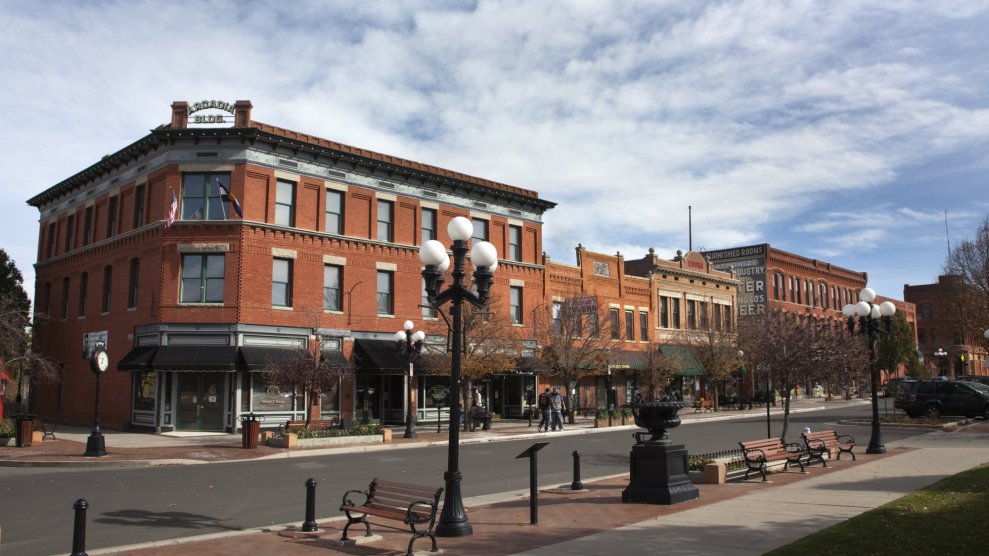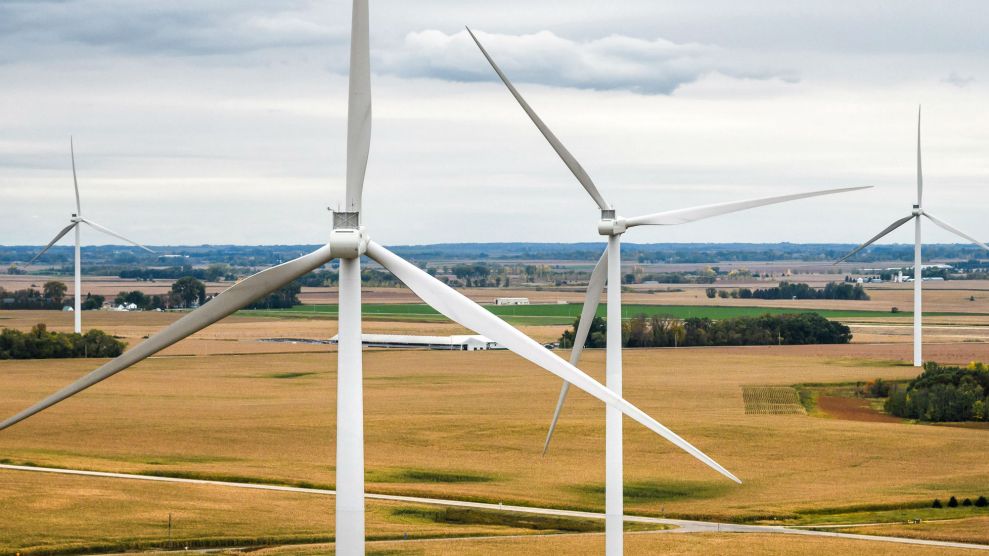
Historic South Pueblomilehightraveler/Getty
This story was originally published by Grist and is reproduced here as part of the Climate Desk collaboration.
The first things you see driving down from the Rocky Mountains into Pueblo, Colorado, are smoke stacks. Three big ones sprout from the Comanche coal plant at the edge of town, and then a stubble of shorter towers rises from the steel mill, which once provided good paying jobs to anyone who wanted one.
Pueblo’s fortunes changed in the 1980s when steel prices crashed, and the mill laid off thousands of workers. One in every five residents now lives below the poverty line. The town looks and feels like a struggling Rust-Belt city in the high desert.
Pueblo used to be called Steel City and “the Pittsburgh of the West” for its industrial prowess. City Councilman Larry Atencio remembers another nickname: “Pue-town” (pronounced “pew-town”), because there was always something spewing from the smokestacks to tickle the nostrils. From his childhood home—a light-green house with a rutted dirt driveway and chain-link fence—Atencio could look toward the steel mill and watch “the night sky just light up when they dumped slag from the open-hearth furnaces over those hills.”
Atencio, wearing a blazer over a blue polo shirt, was waiting for me outside Pueblo’s buff sandstone City Hall. He’s a craggily handsome man, greying at the temples, with a relaxed, avuncular manner. He was once “a little Mexican kid from the lower east side of town,” as he puts it. He expected to join his father in construction but turned into a college student, a soldier, an air-pollution regulator, and an entrepreneur (he invented a way of printing logos on candy). Now, he’s the councilman behind Pueblo’s push to run solely on renewable electricity by 2035.
Atencio hopped in my car, and we toured his hometown. Near the old steel mill, there was a cluster of houses just across a ditch from the mountain of black slag. “You would think that when they stopped dumping in 1984 something would grow on that hill, ”Atencio said. “But not a weed.”
Just beyond the mill is the massive coal plant, but the air above its smokestacks looks clear. The same environmental rules that closed the slag furnaces have cleaned up this plant (though carbon still comes out of the stacks). It’s surrounded by rolling hills of photovoltaic panels, the largest solar installation east of the Rockies when it opened in 2014. A little farther south, massive steel tubes cover acres of ground where the wind-energy giant, Vestas, operates the largest wind-tower factory in the world. This is what it looks like when a renewable energy industry grows in the boneyards of the fossil-fuel economy.
As national politicians squabble over the existence of climate change, many cities are taking practical steps to embrace renewables. The Sierra Club has gotten dozens of cities to sign a pledge to phase out fossil fuels. Five have already managed to buy or produce as much electricity from renewable sources as they consume. They’re the kinds of places you might expect to succeed. Three of them—Kodiak Island, Alaska, Greenberg, Kansas, and Rock Port, Missouri—are tiny and sit next to big dams, big wind turbines, or both. The other two, Burlington, Vermont, and Aspen, Colorado, are affluent ski towns full of environmentalists.
It’s much harder to go 100 percent renewable in a place like Pueblo, where there are lots of poor people struggling to pay their utility bills. Renewable energy can now beat fossil fuel on price when the sun is beating down and the wind is pinwheeling turbines—but providing renewable energy 24 hours a day, 12 months a year is still more expensive. Nonetheless, anti-poverty advocates and environmentalists have have formed a political coalition that’s pushing for renewable energy in Pueblo.
It’s not clear yet what steps the city might take toward this goal: It could switch to a different utility, or maybe negotiate for a new deal with its current provider, Black Hills Energy. It could buy out Black Hills and form a municipal utility, or it could just put up a few solar panels on city buildings and call it a day.
When Atencio introduced the resolution to take Pueblo to 100 percent renewable energy last February, the council chambers were packed. There were the usual white-haired retirees in polar fleece who often show up to back environmental causes, as well as black- and brown-skinned people, and parents with babies. Atencio said the motivating force behind the resolution wasn’t to saving the planet, but outrage over soaring power bills.
“My primary focus is energy justice for low-income people. I understand the benefits of solar and renewables, but our immediate need is some relief,” Atencio said.
The company that had been providing Pueblo’s electricity, Aquila, went belly-up in 2007, and South Dakota-based Black Hills Energy took over, promising to fix up what it said was a poorly neglected system. Over the next decade, the company replaced old electric lines, installed LED street lights, and built new power plants—enough to replace 85 percent of the city’s power generation. Locals paid for it with skyrocketing electric bills. Black Hills disconnected some 7,000 homes when people failed to pay on time. Constituents called Atencio’s office every day asking for help.
But Pueblo was stuck: The city’s franchise agreement with Black Hills lasts until 2020, and as long as it’s in place, the company can charge customers for improvements—plus 9.3 percent that the Colorado Public Utility Commission allows it to make in profit.
In early 2016, a group of pissed-off residents called Pueblo’s Energy Future met with Atencio. They were working with the Sierra Club’s “Ready for 100” campaign in the hope that a shift to more renewable energy would cut their electric bills. “That’s the tip I was kind of looking for,” Atencio said. “Renewables are the future. My thinking is, whether 50 or 100 years, fossil fuels are finite. It’s going to become increasingly expensive to get those things out of the ground.”
On the night Atencio introduced his resolution last year, just one council member spoke out against it. “I’m a realist, you’re never going to get rid of fossil fuels,” said Bob Shilling through a white walrus moustache. Getting Pueblo powered entirely by renewables would raise electricity rates, not lower them, he predicted, provoking boos from the crowd.
The thing is, Shilling wasn’t wrong. It’s true that renewable costs are falling rapidly. But it’s hard for a power company to gin up the money for new hydroelectric dams and solar panels without raising rates.
Artencio’s resolution carries no legal weight—it’s just a statement of intent—but merely exploring the options will cost money. Boulder, which started the push to all renewables before Pueblo, has spent $14 million so far on feasibility studies and legal proceedings—and the city has raised electricity rates to pay for it.
But there was no apparent concern with those details that night in Pueblo City Hall. The resolution passed, and the crowd pressed to the front of the room to take a picture with Atencio and the rest of the city council.
On a cold December morning, I drove across the desert toward the steam rising from the new natural gas plant that Black Hills Energy built in 2011. Julie Rodriguez, the company’s community affairs manager, showed me into a control room filled with flickering monitors. A dancing blue bar graph on one screen showed the electricity flowing from the wind turbines south of Pueblo. Each bar ebbed down and then surged up with gusts of wind.
When those turbines slow down, workers race the engines in this gas plant to produce more electricity. When the wind towers are humming, they shut the engines down.
Paul Hanna, the plant manager, guided me outside to a mobile-home-size steel box, and opened the door. I stepped in and found myself an arms-length from an idle jet engine adapted to turn natural gas into electricity. If the wind stops blowing it can rev to full power in nine minutes.
Inside this metal room with a multi-million dollar generator, it was easy to see why Pueblo’s rates have gone up. If you rely on renewables, you have to pay twice—once for the turbines or solar panels, and once for the backup power (whether it’s a jet engine or a field of batteries) to switch on when the turbines stop spinning or the sun isn’t shining. The city used to get power from old plants, long ago paid off. Now it’s paying for brand new equipment: a new wind farm in the mountains south of Pueblo and a fleet of shiny new jet engines like this one.
When Black Hills Energy raised rates, a lot of that money went toward closing dirty power plants and building cleaner ones. The company shut down an outdated gas plant in downtown Pueblo and an old coal plant in Cañon City (the next town to the west). Black Hills was the first utility in Colorado to eliminate coal from its system. It replaced that dirty power with wind turbines, solar panels, and natural gas. As a result, 19 percent of the electrons streaming from Black Hills Energy to Pueblo come from renewables, and the company is on track to reach 30 percent in the next two years. According to Rodriguez, Pueblo’s electric supply is “one of the cleanest in the state.”
If you hadn’t noticed already, there’s a contradiction here. Black Hills Energy drew the ire of Pueblo by building a cleaner power system and jacking up rates to pay for it. The solution that Atencio and Pueblo’s Energy Future have proposed is to build an even newer, cleaner, system.
And how will the city pay for it? Probably by jacking up rates.
Sister Nancy Crafton, who works as an advocate for the poor at Pueblo’s Centro de Los Pobres, said that while going 100 percent renewable is a wonderful goal, “The cost is probably going to be sent down to the clients.”
Atencio knows there’s a risk that the anger directed at Black Hills will turn against the city. “If the city takes over the electrical company, we’re still going to shut off people who don’t pay,” he said. “The issues are still going to be there. There’s still going to be disgruntled people saying, ‘You promised us lower rates, where are they?’”
But the anger at Black Hills Energy has created a political opportunity that Atencio felt he couldn’t ignore.
“There isn’t a day goes by that somebody comes up to me and says, ‘Get rid of Black Hills,’” he said. “For the state fair parade that goes down Main Street, I was on the city council float waving my little political wave, and there wasn’t a block we passed where a few people didn’t shout, ‘Get rid of Black Hills! Municipalize! Take over!’ This city has the stomach for it, I really believe we do.”
Pueblo officials could finesse things. In theory, the city could shift more of the cost to its wealthiest residents to give poor people a break. It could buy the system from Black Hills Energy, and divert the profits that have been going to shareholders back into the community. But Atencio knows that renewable energy isn’t going to immediately deliver the cheaper power bills his constituents have been clamoring for.
While showing me around Pueblo, Atencio pointed out the neighborhood where he wanted Black Hills Energy to build a solar array. We looped past the community college, which has its own solar panels, and slid between the grand old government buildings downtown. As we pulled to a stop outside City Hall, Atencio told me his next step was to get these municipal buildings onto renewable energy. “Financially, the city is in a position where, we might not be able to do it all at once, but building by building we can start chipping away.”
But what about energy justice—Atencio’s animating force? Was anything in the works to provide immediate relief to poor people struggling to keep up with high energy bills?
“Not much we can do,” Atencio said with a pained wince.
I kept going over this moment, even after I left Pueblo. Atencio primarily wanted to bring relief to low-income people with high electricity bills. And yet the city was preparing to spend money on renewables, not on relief for the poor. What were the people who care about energy justice going to get out of this alliance with greens?
“I’ve wrestled with that exact question,” Atencio said when I emailed him to follow up.
The alliance hasn’t been one-sided, he insisted. The environmentalists showed up to lobby Black Hills Energy to relax billing policies, and Pueblo’s Energy Future succeeded in getting the company to reduce its reconnection fee from $50 to $15. The two are working together to champion a nonprofit developer for a community solar array—one that promises to channel half the benefits to low-income residents. And he hopes that municipal energy-efficiency improvements will lead to savings that the city can divert to help people in need.
“I know that I’m fighting an uphill battle because as you know the plight of the poor isn’t all the rage,” Atencio told me. “I’m working with the environmentalists to get as many backers as possible. And it’s working because I’m the only political person actually working on their issue instead of giving the issue lip service like most politicos do. So they need me as much I need them.”
David Cockrell, one of those greens working with Pueblo’s Energy Future (which is composed of both anti-poverty activists and environmentalists) agreed that they needed Atencio. The connection between renewable energy development and energy justice “is really based on the faith that—in the long run—renewables will bring prices down,” he said. “To be frank, it’s been a stretch the whole way. We’re winging it, man!”
But Cockrell said greens in Pueblo would never take advantage of their energy justice partners. “We’re not going to just push for 100 percent no matter what,” he said. “We don’t want 100 percent renewable energy if it’s going to make it tougher for anyone in Pueblo to have access to it.”
But there’s a danger in suggesting that the goals of greens and anti-poverty advocates are perfectly aligned. Greens have managed to channel anger over high energy prices into a push for renewable power, but that could backfire if building more renewables drives up rates.
You can see the tensions rising over competing goals in Boulder, a few hours north, where the city has been trying to break up with its utility, Xcel, for seven years. That fight started as an effort to squeeze carbon out of Boulder’s electrical supply. To Boulder’s former mayor Will Toor, it seemed as if the goal of cutting carbon became secondary to the goal of winning the fight. The challenge for activists in Pueblo, will be to keep their coalition together as they juggle competing priorities.
There’s something about renewable energy that inspires political optimism. Commit to going 100 percent renewable and it feels like a city has leapt into the future, solving its part of the climate problem in the process. But most cities are just focusing on electricity. People in towns that have declared victory are still burning oil and natural gas to heat their homes, driving around in petroleum-sipping cars, and buying gadgets forged from hydrocarbons.
It’s also unclear that it makes sense for cities to focus on renewables as the tool to slash emissions while also trying to help the poor, because renewables are relatively expensive. According to the California Air Resources Board, a dollar spent on capturing methane from dumps, improving car gas mileage, or planting trees cuts five times as much greenhouse gas as a dollar spent on renewables.
So embracing all-renewable power isn’t the cheapest option. In the campaign for cities to go 100 percent renewable, however, there’s “this strong implication that we are going to be totally renewable and it’s going to cost way less,” said Stanford energy researcher Mark Thurber. “Well, no, that’s not what’s likely to happen.”
In a perfect world, everyone would be clear-eyed about their goals in launching political movements. But political movements don’t run on clear-eyed rationality. They run on anger, on hope, on magical thinking. They rely on people with competing, often contradictory goals convincing themselves they are fighting for the same priorities.
In Pueblo, when high electric prices created a political opening, the Sierra Club was waiting in the wings to offer renewable power as a solution. But that solution came with a knotty problem: It will be a challenge to pay for a renewable building boom while also reducing electric bills for the poor. If Pueblo figures out how to do both, the model could spread. It could work just as well in Toledo, Nashville, or Detroit. And then there’s no reason it wouldn’t work in Belo Horizonte, Brazil, in Raipur, India, in Shenzhen, China.
If you hope to demonstrate that cities can lead in the fight against climate change, you’d want to show you can zero out greenhouse gases in a place where the odds are stacked against such a shift, where people are struggling to keep up with soaring utility bills. You’d want to show it works in an industrial city grappling with poverty, maybe one that voted for Donald Trump. A place, in other words, like Pueblo.
“Pueblo’s not Boulder, it’s not Breckenridge,” said Meral Cooper, the Sierra Club’s “Ready for 100” organizer in Pueblo, pointing to more affluent, and more liberal Colorado cities trying to go renewable. “People are looking at us because if we can make this happen, what does that mean for Detroit?”
For the moment, the odds seem long. But if Pueblo can go 100 percent renewable while also bringing energy justice to its poorest citizens, is there any place that can’t?












